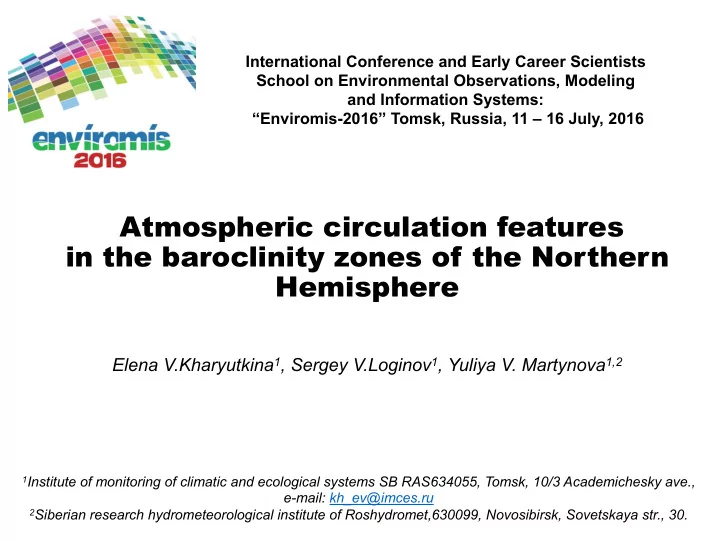

International Conference and Early Career Scientists School on Environmental Observations, Modeling and Information Systems: “Enviromis-2016” Tomsk, Russia, 11 – 16 July, 2016 Atmospheric circulation features in the baroclinity zones of the Northern Hemisphere Elena V.Kharyutkina 1 , Sergey V.Loginov 1 , Yuliya V. Martynova 1,2 1 Institute of monitoring of climatic and ecological systems SB RAS634055, Tomsk, 10/3 Academichesky ave., e-mail: kh_ev@imces.ru 2 Siberian research hydrometeorological institute of Roshydromet,630099, Novosibirsk, Sovetskaya str., 30.
Main goal to estimate the changes of atmospheric circulation characteristics in the baroclinity zones of the Northern Hemisphere at the end of XX and at the beginning of XXI centuries and their influence on the global climate change. 2
Baroclinic instability parameter (BI) (Lindzen & Farrell, 1980) : N - Brunt-Vaisala frequency g T g = 0.31 = N BI z NT y g – free fall acceleration (9,8 m/s 2 ) T – zonal mean temperature ERA Interim http://www.ecmwf.int/en/research/climate-reanalysis/era-interim/ JRA-55 http://jra.kishou.go.jp/JRA-55/index_en.html 3
Baroclinic zones ERA Interim http://www.ecmwf.int/en/research/climate-reanalysis/era-interim/ 4
Conclusion The analysis of statistical estimations of atmospheric circulation characteristics in baroclinity zones and their relationships with variability of zonal, meridional and eddy circulation, which includes synoptic scale and low-frequency variability, was carried out for the Northern Hemisphere. The variability of atmospheric circulation (including large-scale) characteristics can indicate that enhancement of meridional circulation forms is observed. It leads to the development of blocking processes. 5
Recommend
More recommend